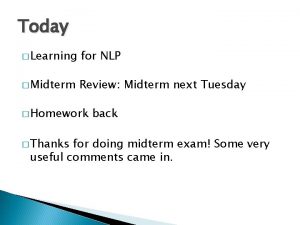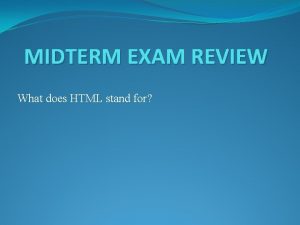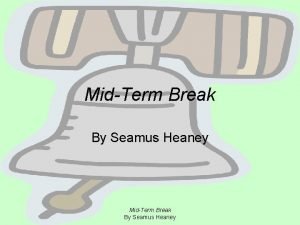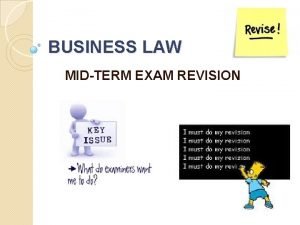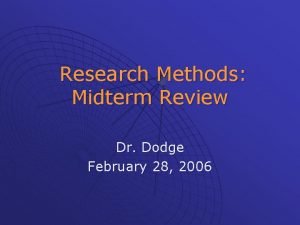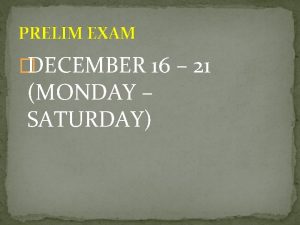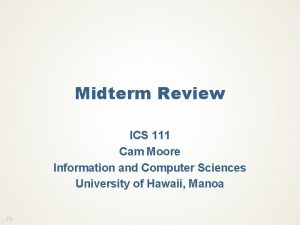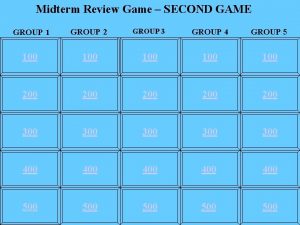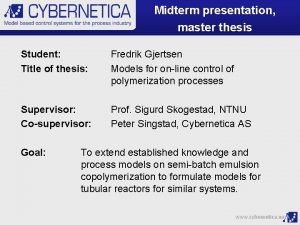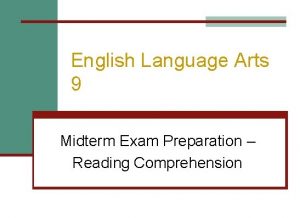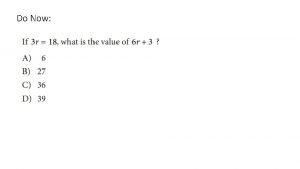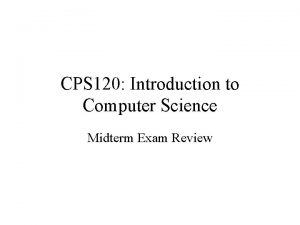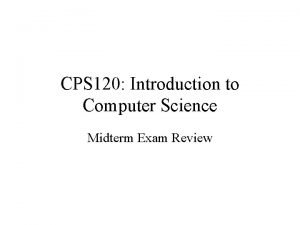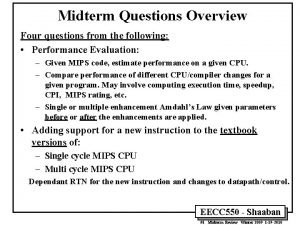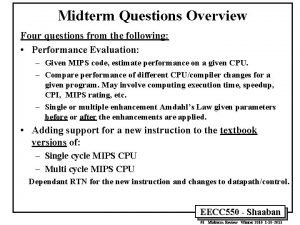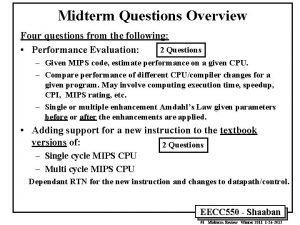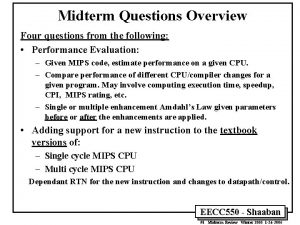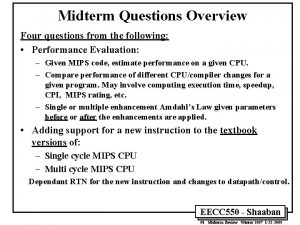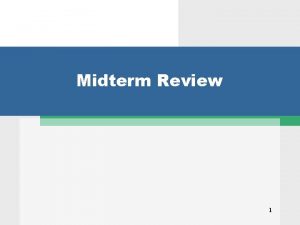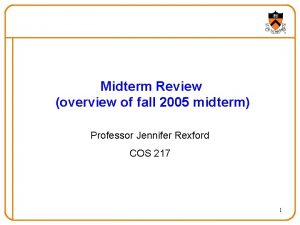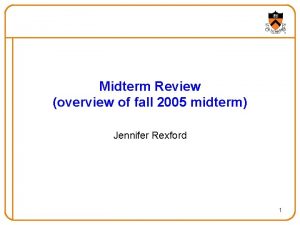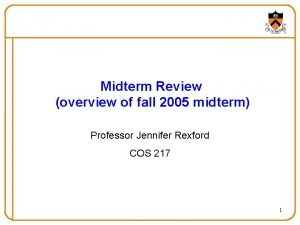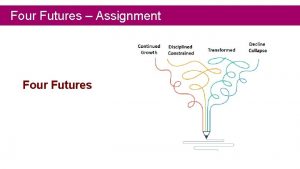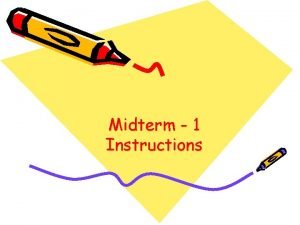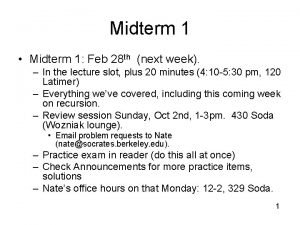Midterm Questions Overview Four questions from the following
















![Example: Simple C Loop to MIPS • Simple loop in C: A[] array of Example: Simple C Loop to MIPS • Simple loop in C: A[] array of](https://slidetodoc.com/presentation_image_h2/ef8a8caff50bcf28b5012b0480347619/image-17.jpg)

































![jump and link, jal support to Single Cycle Datapath Instruction Word ¬ Mem[PC] R[31] jump and link, jal support to Single Cycle Datapath Instruction Word ¬ Mem[PC] R[31]](https://slidetodoc.com/presentation_image_h2/ef8a8caff50bcf28b5012b0480347619/image-51.jpg)




![Adding jump memory, jm support to Single Cycle Datapath Instruction Word ¬ Mem[PC] PC Adding jump memory, jm support to Single Cycle Datapath Instruction Word ¬ Mem[PC] PC](https://slidetodoc.com/presentation_image_h2/ef8a8caff50bcf28b5012b0480347619/image-56.jpg)









![Adding swap Instruction Support to Multi Cycle Datapath IF A ¬ R[rs] IR ¬ Adding swap Instruction Support to Multi Cycle Datapath IF A ¬ R[rs] IR ¬](https://slidetodoc.com/presentation_image_h2/ef8a8caff50bcf28b5012b0480347619/image-66.jpg)


![add 3 instruction support to Multi Cycle Datapath IF A ¬ R[rs] IR ¬ add 3 instruction support to Multi Cycle Datapath IF A ¬ R[rs] IR ¬](https://slidetodoc.com/presentation_image_h2/ef8a8caff50bcf28b5012b0480347619/image-69.jpg)
- Slides: 69

Midterm Questions Overview Four questions from the following: 2 Questions • Performance Evaluation: – Given MIPS code, estimate performance on a given CPU. – Compare performance of different CPU/compiler changes for a given program. May involve computing execution time, speedup, CPI, MIPS rating, etc. – Single or multiple enhancement Amdahl’s Law given parameters before or after the enhancements are applied. • Adding support for a new instruction to the textbook versions of: 2 Questions – Single cycle MIPS CPU – Multi cycle MIPS CPU Dependant RTN for the new instruction and changes to datapath/control. EECC 550 - Shaaban #1 Midterm Review Winter 2012 1 -15 -2013

CPU Organization (Design) • Datapath Design: Components & their connections needed by ISA instructions – Capabilities & performance characteristics of principal Functional Units (FUs) needed by ISA instructions – (e. g. , Registers, ALU, Shifters, Logic Units, . . . ) Components – Ways in which these components are interconnected (buses connections, multiplexors, etc. ). Connections – How information flows between components. • Control Unit Design: Control/sequencing of operations of datapath components to realize ISA instructions – Logic and means by which such information flow is controlled. – Control and coordination of FUs operation to realize the targeted Instruction Set Architecture to be implemented (can either be implemented using a finite state machine or a microprogram). • Hardware description with a suitable language, possibly using Register Transfer Notation (RTN). ISA = Instruction Set Architecture The ISA forms an abstraction layer that sets the requirements for both complier and CPU designers EECC 550 - Shaaban #2 Midterm Review Winter 2012 1 -15 -2013

Reduced Instruction Set Computer (RISC) ~1984 ISAs • Focuses on reducing the number and complexity of instructions of the ISA. RISC: Simplify ISA Simplify CPU Design Better CPU Performance – Motivated by simplifying the ISA and its requirements to: RISC Goals • Reduce CPU design complexity • Improve CPU performance. – CPU Performance Goal: Reduced number of cycles needed per instruction. At least one instruction completed per clock cycle. • Simplified addressing modes supported. – Usually limited to immediate, register indirect, register displacement, indexed. • Load-Store GPR: Only load and store instructions access memory. – (Thus more instructions are usually executed than CISC) • Fixed-length instruction encoding. – (Designed with CPU instruction pipelining in mind). • Support of delayed branches. • Examples: MIPS, HP PA-RISC, SPARC, Alpha, POWER, Power. PC. Chapter 2 (both editions) EECC 550 - Shaaban #3 Midterm Review Winter 2012 1 -15 -2013

RISC ISA Example: MIPS R 3000 (32 -bit) • • Memory: Can address 232 bytes or 230 words (32 -bits). Instruction Categories: – Load/Store. – Computational: ALU. – Jump and Branch. – Floating Point. • Using coprocessor – Memory Management. – Special. 5 Addressing Modes: • • • Register direct (arithmetic). Immedate (arithmetic). Base register + immediate offset (loads and stores). PC relative (branches). Pseudodirect (jumps) Registers R 0 - R 31 31 GPRs R 0 = 0 (each 32 bits) PC HI Operand Sizes: • Memory accesses in any multiple between 1 and 4 bytes. LO Instruction Encoding: 3 Instruction Formats, all 32 bits wide. R-Type OP rs rt I-Type: ALU OP rs rt Load/Store, Branch J-Type: Jumps OP Word = 4 bytes = 32 bits rd sa funct immediate jump target EECC 550 - Shaaban #4 Midterm Review Winter 2012 1 -15 -2013

MIPS Register Usage/Naming Conventions • In addition to the usual naming of registers by $ followed with register number, registers are also named according to MIPS register usage convention as follows: Register Number Name 0 1 2 -3 $zero $at $v 0 -$v 1 4 -7 8 -15 16 -23 24 -25 26 -27 28 29 30 31 $a 0 -$a 3 $t 0 -$t 7 $s 0 -$s 7 $t 8 -$t 9 $k 0 -$k 1 $gp $sp $fp $ra Usage Preserved on call? Constant value 0 Reserved for assembler Values for result and expression evaluation Arguments Temporaries Saved More temporaries Reserved for operating system Global pointer Stack pointer Frame pointer Return address n. a. no no yes yes yes EECC 550 - Shaaban #5 Midterm Review Winter 2012 1 -15 -2013

MIPS Five Addressing Modes 1 Register Addressing: e. g. add $1, $2, $3 Where the operand is a register (R-Type) 2 Immediate Addressing: e. g. addi $1, $2, 100 Where the operand is a constant in the instruction (I-Type, ALU) 3 Base or Displacement Addressing: e. g. lw $1, 32($2) Where the operand is at the memory location whose address is the sum of a register and a constant in the instruction (I-Type, load/store) 4 PC-Relative Addressing: e. g. beq $1, $2, 100 Where the address is the sum of the PC and the 16 -address field in the instruction shifted left 2 bits. (I-Type, branches) 5 Pseudodirect Addressing: e. g. j 10000 Where the jump address is the 26 -bit jump target from the instruction shifted left 2 bits concatenated with the 4 upper bits of the PC (J-Type) EECC 550 - Shaaban #6 Midterm Review Winter 2012 1 -15 -2013

MIPS R-Type (ALU) Instruction Fields R-Type: All ALU instructions that use three registers 1 st operand OP 6 bits [31: 26] • • • rs 5 bits [25: 21] 2 nd operand rt 5 bits [20: 16] Destination rd shamt funct 5 bits 6 bits [15: 11] [10: 6] [5: 0] op: Opcode, basic operation of the instruction. Rs, rt , rd – For R-Type op = 0 are register specifier fields rs: The first register source operand. Independent RTN: rt: The second register source operand. R[rd] ¬ R[rs] funct R[rt] rd: The register destination operand. PC ¬ PC + 4 shamt: Shift amount used in constant shift operations. funct: Function, selects the specific variant of operation in the op field. Funct field value examples: Add = 32 Sub = 34 AND = 36 OR =37 NOR = 39 Operand register in rs Destination register in rd Examples: add $1, $2, $3 sub $1, $2, $3 R-Type = Register Type Register Addressing used (Mode 1) Operand register in rt and $1, $2, $3 or $1, $2, $3 EECC 550 - Shaaban #7 Midterm Review Winter 2012 1 -15 -2013

MIPS ALU I-Type Instruction Fields I-Type ALU instructions that use two registers and an immediate value (I-Type is also used for Loads/stores, conditional branches). 1 st operand • • Destination 2 nd operand OP rs rt 6 bits 5 bits 16 bits [31: 26] [25: 21] [20: 16] [15: 0] immediate op: Opcode, operation of the instruction. Independent RTN for addi: rs: The register source operand. R[rt] ¬ R[rs] + immediate PC ¬ PC + 4 rt: The result destination register. immediate: Constant second operand for ALU instruction. OP = 8 Examples: OP = 12 Result register in rt Source operand register in rs add immediate: addi $1, $2, 100 and immediate andi $1, $2, 10 I-Type = Immediate Type Immediate Addressing used (Mode 2) Constant operand in immediate EECC 550 - Shaaban #8 Midterm Review Winter 2012 1 -15 -2013

MIPS Load/Store I-Type Instruction Fields Base • • Src. /Dest. imm 16 OP rs rt 6 bits 5 bits 16 bits [31: 26] [25: 21] [20: 16] [15: 0] address (e. g. offset) Signed address offset in bytes op: Opcode, operation of the instruction. – For load word op = 35, for store word op = 43. rs: The register containing memory base address. rt: For loads, the destination register. For stores, the source register of value to be stored. address: 16 -bit memory address offset in bytes added to base register. Examples: source register in rt Offset Store word: sw $3, 500($4) Load word: lw $1, 32($2) Destination register in rt Offset Base or Displacement Addressing used (Mode 3) base register in rs Mem[R[rs] + address] ¬ R[rt] PC ¬ PC + 4 R[rt] ¬ Mem[R[rs] + address] PC ¬ PC + 4 base register in rs EECC 550 - Shaaban #9 Midterm Review Winter 2012 1 -15 -2013

MIPS Branch I-Type Instruction Fields imm 16 OP rs rt 6 bits 5 bits [31: 26] • • [25: 21] address (e. g. offset) 16 bits [20: 16] [15: 0] Signed address offset in words op: Opcode, operation of the instruction. Word = 4 bytes rs: The first register being compared rt: The second register being compared. address: 16 -bit memory address branch target offset in words added to PC to form branch address. Register in rt Register in rs OP = 4 Examples: OP = 5 Branch on equal beq $1, $2, 100 Branch on not equal bne $1, $2, 100 offset in bytes equal to instruction address field x 4 Added to PC+4 to form branch target Independent RTN for beq: R[rs] = R[rt] : R[rs] ¹ R[rt] : PC ¬ PC + 4 + address x 4 PC ¬ PC + 4 PC-Relative Addressing used (Mode 4) EECC 550 - Shaaban #10 Midterm Review Winter 2012 1 -15 -2013

MIPS J-Type Instruction Fields J-Type: Include jump j, jump and link jal OP jump target 6 bits 26 bits [31: 26] • • op: Opcode, operation of the instruction. – Jump j op = 2 – Jump and link jal op = 3 jump target: jump memory address in words. Examples: Word = 4 bytes Jump memory address in bytes equal to instruction field jump target x 4 Jump j 10000 Jump and link jal 10000 Effective 32 -bit jump address: PC(31 -28) From PC+4 4 bits Independent RTN for j: Jump target in words [25: 0] PC(31 -28), jump_target, 00 jump target = 2500 26 bits 0 0 2 bits PC ¬ PC + 4 PC ¬ PC(31 -28), jump_target, 00 J-Type = Jump Type Pseudodirect Addressing used (Mode 5) EECC 550 - Shaaban #11 Midterm Review Winter 2012 1 -15 -2013

MIPS Addressing Modes/Instruction Formats • All instructions 32 bits wide First Operand 1 Register (direct) op R-Type Second Operand rs rt Destination rd register I-Type First Operand 2 Immediate 3 Displacement: Base+index (load/store) op rs Base op Second Operand Destination rs rt immed src/dest rt immed register 4 PC-relative (branches) op rs rt Memory + immed Memory Shifted left 2 bits PC Pseudodirect Addressing (Mode 5) not shown here, illustrated in the last slide for J-Type + EECC 550 - Shaaban #12 Midterm Review Winter 2012 1 -15 -2013

MIPS Arithmetic Instructions Examples (Integer) Instruction Example Meaning Comments add $1, $2, $3 $1 = $2 + $3 3 operands; exception possible subtract sub $1, $2, $3 $1 = $2 – $3 3 operands; exception possible add immediate addi $1, $2, 100 $1 = $2 + 100 + constant; exception possible add unsigned addu $1, $2, $3 $1 = $2 + $3 3 operands; no exceptions subtract unsigned subu $1, $2, $3 $1 = $2 – $3 3 operands; no exceptions add imm. unsign. addiu $1, $2, 100 $1 = $2 + 100 + constant; no exceptions multiply mult $2, $3 Hi, Lo = $2 x $3 64 -bit signed product multiply unsigned multu$2, $3 Hi, Lo = $2 x $3 64 -bit unsigned product divide div $2, $3 Lo = $2 ÷ $3, Lo = quotient, Hi = remainder Hi = $2 mod $3 divide unsigned divu $2, $3 Lo = $2 ÷ $3, Unsigned quotient & remainder Hi = $2 mod $3 Move from Hi mfhi $1 $1 = Hi Used to get copy of Hi Move from Lo mflo $1 $1 = Lo Used to get copy of Lo EECC 550 - Shaaban #13 Midterm Review Winter 2012 1 -15 -2013

MIPS Logic/Shift Instructions Examples Instruction Example Meaning Comment and $1, $2, $3 $1 = $2 & $3 3 reg. operands; Logical AND or or $1, $2, $3 $1 = $2 | $3 3 reg. operands; Logical OR xor $1, $2, $3 $1 = $2 $3 3 reg. operands; Logical XOR nor $1, $2, $3 $1 = ~($2 |$3) 3 reg. operands; Logical NOR and immediate andi $1, $2, 10 $1 = $2 & 10 Logical AND reg, constant or immediate ori $1, $2, 10 $1 = $2 | 10 Logical OR reg, constant xor immediate xori $1, $2, 10 $1 = ~$2 &~10 Logical XOR reg, constant shift left logical sll $1, $2, 10 $1 = $2 << 10 Shift left by constant shift right logical srl $1, $2, 10 $1 = $2 >> 10 Shift right by constant shift right arithm. sra $1, $2, 10 $1 = $2 >> 10 Shift right (sign extend) shift left logical sllv $1, $2, $3 $1 = $2 << $3 Shift left by variable shift right logical srlv $1, $2, $3 $1 = $2 >> $3 Shift right by variable shift right arithm. srav $1, $2, $3 $1 = $2 >> $3 Shift right arith. by variable EECC 550 - Shaaban #14 Midterm Review Winter 2012 1 -15 -2013

MIPS Data Transfer Instructions Examples Instruction sw $3, 500($4) sh $3, 502($2) sb $2, 41($3) Comment Store word Store half word Store byte lw $1, 30($2) lh $1, 40($3) lhu $1, 40($3) lbu $1, 40($3) Load word Load half word unsigned Load byte unsigned Word = 4 bytes lui $1, 40 Load Upper Immediate (16 bits shifted left by 16) LUI R 5 0000 … 0000 EECC 550 - Shaaban #15 Midterm Review Winter 2012 1 -15 -2013

MIPS Branch, Compare, Jump Instructions Examples Instruction branch on equal branch on not eq. set on less than Example Meaning beq $1, $2, 100 if ($1 == $2) go to PC+4+100 Equal test; PC relative branch bne $1, $2, 100 if ($1!= $2) go to PC+4+100 Not equal test; PC relative branch slt $1, $2, $3 set less than imm. slti $1, $2, 100 Compare < constant; 2’s comp. set less than uns. sltu $1, $2, $3 if ($2 < $3) $1=1; else $1=0 Compare less than; 2’s comp. if ($2 < 100) $1=1; else $1=0 if ($2 < $3) $1=1; else $1=0 Compare less than; natural numbers set l. t. imm. uns. sltiu $1, $2, 100 if ($2 < 100) $1=1; else $1=0 Compare < constant; natural numbers jump j 10000 go to 10000 Jump to target address jump register jr $31 go to $31 For switch, procedure return jump and link jal 10000 $31 = PC + 4; go to 10000 For procedure call EECC 550 - Shaaban #16 Midterm Review Winter 2012 1 -15 -2013
![Example Simple C Loop to MIPS Simple loop in C A array of Example: Simple C Loop to MIPS • Simple loop in C: A[] array of](https://slidetodoc.com/presentation_image_h2/ef8a8caff50bcf28b5012b0480347619/image-17.jpg)
Example: Simple C Loop to MIPS • Simple loop in C: A[] array of words in memory Loop: g = g + A[i]; i = i + j; if (i != h) goto Loop; • Assume MIPS register mapping: g: $s 1, h: $s 2, i: $s 3, j: $s 4, base of A[]: $s 5 • MIPS Instructions: Loop: add add lw add bne Word = 4 bytes $t 1, $s 3 $t 1, $t 1, $s 5 $t 1, 0($t 1) $s 1, $t 1 $s 3, $s 4 $s 3, $s 2, Loop # # # # $t 1= 2*i $t 1= 4*i $t 1=address of A[I] $t 1= A[i] g = g + A[i] I = i + j goto Loop if i!=h EECC 550 - Shaaban #17 Midterm Review Winter 2012 1 -15 -2013

CPU Performance Evaluation: Cycles Per Instruction (CPI) • Most computers run synchronously utilizing a CPU clock running at a constant clock rate: Or clock frequency: f Clock cycle where: Clock rate = 1 / clock cycle f • • = 1/C cycle 1 cycle 2 cycle 3 The CPU clock rate depends on the specific CPU organization (design) and hardware implementation technology (VLSI) used. A computer machine (ISA) instruction is comprised of a number of elementary or micro operations which vary in number and complexity depending on the instruction and the exact CPU organization (Design). – A micro operation is an elementary hardware operation that can be performed during one CPU clock cycle. – This corresponds to one micro-instruction in microprogrammed CPUs. – Examples: register operations: shift, load, clear, increment, ALU operations: add , subtract, etc. • Thus: A single machine instruction may take one or more CPU cycles to complete termed as the Cycles Per Instruction (CPI). Instructions Per Cycle = IPC = 1/CPI • Average (or effective) CPI of a program: The average CPI of all instructions executed in the program on a given CPU design. 4 th Edition: Chapter 1 (1. 4, 1. 7, 1. 8) 3 rd Edition: Chapter 4 Cycles/sec = Hertz = Hz MHz = 106 Hz GHz = 109 Hz EECC 550 - Shaaban #18 Midterm Review Winter 2012 1 -15 -2013

Computer Performance Measures: Program Execution Time • For a specific program compiled to run on a specific machine (CPU) “A”, has the following parameters: – The total executed instruction count of the program. I – The average number of cycles per instruction (average CPI). CPI – Clock cycle of machine “A” C Or effective CPI • How can one measure the performance of this machine (CPU) running this program? – Intuitively the machine (or CPU) is said to be faster or has better performance running this program if the total execution time is shorter. – Thus the inverse of the total measured program execution time is a possible performance measure or metric: Seconds/program Programs/second Performance. A = 1 / Execution Time. A How to compare performance of different machines? What factors affect performance? How to improve performance? EECC 550 - Shaaban #19 Midterm Review Winter 2012 1 -15 -2013

Comparing Computer Performance Using Execution Time • To compare the performance of two machines (or CPUs) “A”, “B” running a given specific program: Performance. A = 1 / Execution Time. A Performance. B = 1 / Execution Time. B • Machine A is n times faster than machine B means (or slower? if n < 1) : Speedup = n = • Performance. A Performance. B Example: For a given program: Execution time on machine A: Execution time on machine B: Speedup= Performance. A / Performance. B = Execution Time. B Execution Time. A (i. e Speedup is ratio of performance, no units) Execution. A = 1 second Execution. B = 10 seconds = Execution Time. B / Execution Time. A = 10 / 1 = 10 The performance of machine A is 10 times the performance of machine B when running this program, or: Machine A is said to be 10 times faster than machine B when running this program. The two CPUs may target different ISAs provided the program is written in a high level language (HLL) EECC 550 - Shaaban #20 Midterm Review Winter 2012 1 -15 -2013

CPU Execution Time: The CPU Equation • A program is comprised of a number of instructions executed , I – Measured in: instructions/program • The average instruction executed takes a number of cycles per instruction (CPI) to be completed. Or Instructions Per Cycle (IPC): – Measured in: cycles/instruction, CPI IPC = 1/CPI • CPU has a fixed clock cycle time C = 1/clock rate – Measured in: seconds/cycle C = 1/f • CPU execution time is the product of the above three parameters as follows: Executed CPU time = Seconds Program T = execution Time per program in seconds = Instructions x Cycles Program Instruction I x Number of instructions executed x Seconds CPI x Average CPI for program (This equation is commonly known as the CPU performance equation) Cycle C CPU Clock Cycle EECC 550 - Shaaban #21 Midterm Review Winter 2012 1 -15 -2013

CPU Execution Time: Example • A Program is running on a specific machine (CPU) with the following parameters: – Total executed instruction count: 10, 000 instructions – Average CPI for the program: 2. 5 cycles/instruction. – CPU clock rate: 200 MHz. (clock cycle = C = 5 x 10 -9 seconds) • What is the execution time for this program: CPU time = Seconds Program = Instructions x Cycles Program Instruction i. e 5 nanoseconds x Seconds Cycle CPU time = Instruction count x CPI x Clock cycle = 10, 000 x 2. 5 x 1 / clock rate = 10, 000 x 2. 5 x 5 x 10 -9 = 0. 125 seconds Nanosecond = nsec =ns = 10 -9 second T = I x CPI x C EECC 550 - Shaaban #22 Midterm Review Winter 2012 1 -15 -2013

Factors Affecting CPU Performance CPU time = Seconds = Instructions x Cycles Program T = Program I x Instruction CPI Instruction Count Cycles per Instruction Program X X Compiler X X Instruction Set Architecture (ISA) X X Organization (CPU Design) Technology (VLSI) x Seconds X x Cycle C Clock Cycle Time X X EECC 550 - Shaaban #23 Midterm Review Winter 2012 1 -15 -2013

Performance Comparison: Example • From the previous example: A Program is running on a specific machine (CPU) with the following parameters: – Total executed instruction count, I: 10, 000 instructions – Average CPI for the program: 2. 5 cycles/instruction. – CPU clock rate: 200 MHz. Thus: C = 1/(200 x 10 )= 5 x 10 seconds • Using the same program with these changes: – A new compiler used: New executed instruction count, I: 9, 500, 000 New CPI: 3. 0 – Faster CPU implementation: New clock rate = 300 MHz Thus: C = 1/(300 x 10 )= 3. 33 x 10 seconds • What is the speedup with the changes? 6 -9 6 Speedup = Old Execution Time = Iold x New Execution Time Inew x CPIold x Clock cycleold CPInew x Clock Cyclenew -9 Speedup = (10, 000 x 2. 5 x 5 x 10 -9) / (9, 500, 000 x 3. 33 x 10 -9 ) =. 125 /. 095 = 1. 32 or 32 % faster after changes. Clock Cycle = C = 1/ Clock Rate T = I x CPI x C EECC 550 - Shaaban #24 Midterm Review Winter 2012 1 -15 -2013

Instruction Types & CPI • Given a program with n types or classes of instructions executed on given CPU with the following characteristics: Ci = Count of instructions of typei executed CPIi = Cycles per instruction for typei Then: a i = 1, 2, …. n Depends on CPU Design CPI = CPU Clock Cycles / Instruction Count I i. e average or effective CPI Where: Executed Instruction Count I = S Ci T = I x CPI x C EECC 550 - Shaaban #25 Midterm Review Winter 2012 1 -15 -2013

Instruction Types & CPI: An Example • An instruction set has three instruction classes: Instruction class A B C CPI 1 2 3 For a specific CPU design • Two code sequences have the following instruction counts: Code Sequence 1 2 Instruction counts for instruction class A B C 2 1 2 4 1 1 • CPU cycles for sequence 1 = 2 x 1 + 1 x 2 + 2 x 3 = 10 cycles CPI for sequence 1 = clock cycles / instruction count i. e average or effective CPI = 10 /5 = 2 • CPU cycles for sequence 2 = 4 x 1 + 1 x 2 + 1 x 3 = 9 cycles CPI for sequence 2 = 9 / 6 = 1. 5 CPI = CPU Cycles / I EECC 550 - Shaaban #26 Midterm Review Winter 2012 1 -15 -2013

Instruction Frequency & CPI • Given a program with n types or classes of instructions with the following characteristics: i = 1, 2, …. n Ci = Count of instructions of typei executed CPIi = Average cycles per instruction of typei Fi = Frequency or fraction of instruction typei executed = Ci/ total executed instruction count = Ci/ I Where: Executed Instruction Count I = S C Then: i. e average or effective CPI Fraction of total execution time for instructions of type i = T = I x CPI x C CPIi x Fi CPI EECC 550 - Shaaban #27 Midterm Review Winter 2012 1 -15 -2013 i

Instruction Type Frequency & CPI: A RISC Example CPIi x Fi Program Profile or Executed Instructions Mix Given Base Machine (Reg / Reg) Op Freq, Fi CPIi ALU 50% 1 Load 20% 5 Store 10% 3 Branch 20% 2 Typical Mix CPI Depends on CPU Design CPIi x Fi. 5 1. 0. 3. 4 % Time 23% =. 5/2. 2 45% = 1/2. 2 14% =. 3/2. 2 18% =. 4/2. 2 Sum = 2. 2 i. e average or effective CPI =. 5 x 1 +. 2 x 5 +. 1 x 3 +. 2 x 2 = 2. 2 =. 5 + 1 +. 3 +. 4 EECC 550 - Shaaban #28 Midterm Review Winter 2012 1 -15 -2013

• Computer Performance Measures : MIPS (Million Instructions Per Second) Rating For a specific program running on a specific CPU the MIPS rating is a measure of how many millions of instructions are executed per second: MIPS Rating = Instruction count / (Execution Time x 106) = Instruction count / (CPU clocks x Cycle time x 106) = (Instruction count x Clock rate) / (Instruction count x CPI x 106) = Clock rate / (CPI x 106) • Major problem with MIPS rating: As shown above the MIPS rating does not account for the count of instructions executed (I). – A higher MIPS rating in many cases may not mean higher performance or better execution time. i. e. due to compiler design variations. • In addition the MIPS rating: – Does not account for the instruction set architecture (ISA) used. • Thus it cannot be used to compare computers/CPUs with different instruction sets. – Easy to abuse: Program used to get the MIPS rating is often omitted. • Often the Peak MIPS rating is provided for a given CPU which is obtained using a program comprised entirely of instructions with the lowest CPI for the given CPU design which does not represent real programs. T = I x CPI x C EECC 550 - Shaaban #29 Midterm Review Winter 2012 1 -15 -2013

Computer Performance Measures : MIPS (Million Instructions Per Second) Rating • Under what conditions can the MIPS rating be used to compare performance of different CPUs? • The MIPS rating is only valid to compare the performance of different CPUs provided that the following conditions are satisfied: 1 The same program is used (actually this applies to all performance metrics) 2 The same ISA is used 3 The same compiler is used Þ (Thus the resulting programs used to run on the CPUs and obtain the MIPS rating are identical at the machine code (binary) level including the same instruction count) EECC 550 - Shaaban #30 Midterm Review Winter 2012 1 -15 -2013

Compiler Variations, MIPS & Performance: An Example • For a machine (CPU) with instruction classes: Instruction class A B C CPI 1 2 3 • For a given high-level language program, two compilers produced the following executed instruction counts: Code from: Compiler 1 Compiler 2 Instruction counts (in millions) for each instruction class A B C 5 1 1 10 1 1 • The machine is assumed to run at a clock rate of 100 MHz. EECC 550 - Shaaban #31 Midterm Review Winter 2012 1 -15 -2013

Compiler Variations, MIPS & Performance: An Example (Continued) MIPS = Clock rate / (CPI x 106) = 100 MHz / (CPI x 106) CPI = CPU execution cycles / Instructions count CPU time = Instruction count x CPI / Clock rate • For compiler 1: – CPI 1 = (5 x 1 + 1 x 2 + 1 x 3) / (5 + 1) = 10 / 7 = 1. 43 – MIPS Rating 1 = 100 / (1. 428 x 106) = 70. 0 MIPS – CPU time 1 = ((5 + 1) x 106 x 1. 43) / (100 x 106) = 0. 10 seconds • For compiler 2: – CPI 2 = (10 x 1 + 1 x 2 + 1 x 3) / (10 + 1) = 15 / 12 = 1. 25 – MIPS Rating 2 = 100 / (1. 25 x 106) = 80. 0 MIPS – CPU time 2 = ((10 + 1) x 106 x 1. 25) / (100 x 106) = 0. 15 seconds MIPS rating indicates that compiler 2 is better while in reality the code produced by compiler 1 is faster EECC 550 - Shaaban #32 Midterm Review Winter 2012 1 -15 -2013

MIPS (The ISA not the metric) Loop Performance Example High Memory $6 points here For the loop: X[999] X[998] . . for (i=0; i<1000; i=i+1){ x[i] = x[i] + s; } $2 initially MIPS assembly code is given by: loop: lw addi lw add sw addi bne $3, $6, $4, $5, $2, $6, 8($1) $2, 4000 0($2) $4, $3 0($2) $2, 4 $2, loop Last element to compute points here ; ; ; ; X[0] Low Memory First element to compute load s in $3 $6 = address of last element + 4 load x[i] in $4 $5 has x[i] + s store computed x[i] increment $2 to point to next x[ ] element last loop iteration reached? The MIPS code is executed on a specific CPU that runs at 500 MHz (clock cycle = 2 ns = 2 x 10 -9 seconds) with following instruction type CPIs : For this MIPS code running on this CPU find: Instruction type ALU Load Store Branch CPI 4 5 7 3 1 - Fraction of total instructions executed for each instruction type 2 - Total number of CPU cycles 3 - Average CPI 4 - Fraction of total execution time for each instructions type 5 - Execution time 6 - MIPS rating , peak MIPS rating for this CPU X[ ] array of words in memory, base address in $2 , s a constant word value in memory, address in $1 EECC 550 - Shaaban #33 Midterm Review Winter 2012 1 -15 -2013

MIPS (The ISA) Loop Performance Example (continued) • • The code has 2 instructions before the loop and 5 instructions in the body of the loop which iterates 1000 times, Thus: Total instructions executed, I = 5 x 1000 + 2 = 5002 instructions 1 Number of instructions executed/fraction Fi for each instruction type: – – ALU instructions = 1 + 2 x 1000 = 2001 Load instructions = 1 + 1 x 1000 = 1001 Store instructions = 1000 Branch instructions = 1000 CPIALU = 4 Fraction. ALU = FALU = 2001/5002 = 0. 4 = 40% CPILoad = 5 Fraction. Load = FLoad = 1001/5002= 0. 2 = 20% CPIStore = 7 Fraction. Store = FStore = 1000/5002 = 0. 2 = 20% CPIBranch = 3 Fraction. Branch= FBranch = 1000/5002= 0. 2 = 20% 2 3 4 = 2001 x 4 + 1001 x 5 + 1000 x 7 + 1000 x 3 = 23009 cycles Average CPI = CPU clock cycles / I = 23009/5002 = 4. 6 Instruction type Fraction of execution time for each instruction type: – – Fraction of time for ALU instructions = CPIALU x FALU / CPI= 4 x 0. 4/4. 6 = 0. 348 = 34. 8% Fraction of time for load instructions = CPIload x Fload / CPI= 5 x 0. 2/4. 6 = 0. 217 = 21. 7% Fraction of time for store instructions = CPIstore x Fstore / CPI= 7 x 0. 2/4. 6 = 0. 304 = 30. 4% Fraction of time for branch instructions = CPIbranch x Fbranch / CPI= 3 x 0. 2/4. 6 = 0. 13 = 13% CPI ALU Load Store Branch 4 5 7 3 5 Execution time = I x CPI x C = CPU cycles x C = 23009 x 2 x 10 -9 = = 4. 6 x 10 -5 seconds = 0. 046 msec = 46 usec 6 MIPS rating = Clock rate / (CPI x 106) = 500 / 4. 6 = 108. 7 MIPS – The CPU achieves its peak MIPS rating when executing a program that only has instructions of the type with the lowest CPI. In this case branches with CPIBranch = 3 – Peak MIPS rating = Clock rate / (CPIBranch x 106) = 500/3 = 166. 67 MIPS EECC 550 - Shaaban #34 Midterm Review Winter 2012 1 -15 -2013

Performance Enhancement Calculations: Amdahl's Law • The performance enhancement possible due to a given design improvement is limited by the amount that the improved feature is used • Amdahl’s Law: Performance improvement or speedup due to enhancement E: Execution Time without E Speedup(E) = -------------------Execution Time with E original Performance with E = ----------------Performance without E – Suppose that enhancement E accelerates a fraction F of the execution time by a factor S and the remainder of the time is unaffected then: Execution Time with E = ((1 -F) + F/S) X Execution Time without E Hence speedup is given by: Execution Time without E 1 Speedup(E) = ----------------------------- = ----------((1 - F) + F/S) X Execution Time without E (1 - F) + F/S F (Fraction of execution time enhanced) refers to original execution time before the enhancement is applied EECC 550 - Shaaban #35 Midterm Review Winter 2012 1 -15 -2013

Pictorial Depiction of Amdahl’s Law Enhancement E accelerates fraction F of original execution time by a factor of S Before: Execution Time without enhancement E: (Before enhancement is applied) • shown normalized to 1 = (1 -F) + F =1 Unaffected fraction: (1 - F) Affected fraction: F Unchanged Unaffected fraction: (1 - F) After: Execution Time with enhancement E: F/S What if the fraction given is after the enhancement has been applied? How would you solve the problem? (i. e find expression for speedup) Execution Time without enhancement E 1 Speedup(E) = --------------------------- = ---------Execution Time with enhancement E (1 - F) + F/S EECC 550 - Shaaban #36 Midterm Review Winter 2012 1 -15 -2013

Performance Enhancement Example • For the RISC machine with the following instruction mix given earlier: Op ALU Load Store Freq 50% 20% 10% Cycles 1 5 3 CPI(i). 5 1. 0. 3 % Time 23% 45% 14% CPI = 2. 2 Branch 20% 2. 4 18% • If a CPU design enhancement improves the CPI of load instructions from 5 to 2, what is the resulting performance improvement from this enhancement: Fraction enhanced = F = 45% or. 45 Unaffected fraction = 100% - 45% = 55% or. 55 Factor of enhancement = 5/2 = 2. 5 Using Amdahl’s Law: 1 1 Speedup(E) = --------------------- = (1 - F) + F/S. 55 +. 45/2. 5 1. 37 EECC 550 - Shaaban #37 Midterm Review Winter 2012 1 -15 -2013

An Alternative Solution Using CPU Equation Op ALU Load Store Freq 50% 20% 10% Cycles 1 5 3 CPI(i). 5 1. 0. 3 % Time 23% 45% 14% CPI = 2. 2 Branch 20% 2. 4 18% • If a CPU design enhancement improves the CPI of load instructions from 5 to 2, what is the resulting performance improvement from this enhancement: New CPI of load is now 2 instead of 5 Old CPI = 2. 2 New CPI =. 5 x 1 +. 2 x 2 +. 1 x 3 +. 2 x 2 = 1. 6 Original Execution Time Speedup(E) = -----------------New Execution Time Instruction count x old CPI x clock cycle = --------------------------------Instruction count x new CPI x clock cycle old CPI = ------ = new CPI 2. 2 ----1. 6 = 1. 37 Which is the same speedup obtained from Amdahl’s Law in the first solution. T = I x CPI x C EECC 550 - Shaaban #38 Midterm Review Winter 2012 1 -15 -2013

Performance Enhancement Example • A program runs in 100 seconds on a machine with multiply operations responsible for 80 seconds of this time. By how much must the speed of multiplication be improved to make the program four times faster? Desired speedup = 4 = 100 --------------------------Execution Time with enhancement ® Execution time with enhancement ® ® = 100/4 = 25 seconds = (100 - 80 seconds) + 80 seconds / S 25 seconds = 20 seconds + 80 seconds / S 5 = 80 seconds / S S = 80/5 = 16 Alternatively, it can also be solved by finding enhanced fraction of execution time: F = 80/100 =. 8 and then solving Amdahl’s speedup equation for desired enhancement factor S 1 Speedup(E) = --------- = 4 = (1 - F) + F/S 1 1 --------- = -------(1 -. 8) +. 8/S. 2 +. 8/s Hence multiplication should be 16 times faster to get an overall speedup of 4. Machine = CPU Solving for S gives S= 16 EECC 550 - Shaaban #39 Midterm Review Winter 2012 1 -15 -2013

Extending Amdahl's Law To Multiple Enhancements n enhancements each affecting a different portion of execution time • Suppose that enhancement Ei accelerates a fraction Fi of the original execution time by a factor Si and the remainder of the time is unaffected then: i = 1, 2, …. n Unaffected fraction What if the fractions given are after the enhancements were applied? How would you solve the problem? (i. e find expression for speedup) Note: All fractions Fi refer to original execution time before the enhancements are applied. EECC 550 - Shaaban #40 Midterm Review Winter 2012 1 -15 -2013

Amdahl's Law With Multiple Enhancements: Example • Three CPU performance enhancements are proposed with the following speedups and percentage of the code execution time affected: Speedup 1 = S 1 = 10 Speedup 2 = S 2 = 15 Speedup 3 = S 3 = 30 • • • Percentage 1 = F 1 = 20% Percentage 1 = F 2 = 15% Percentage 1 = F 3 = 10% While all three enhancements are in place in the new design, each enhancement affects a different portion of the code and only one enhancement can be used at a time. What is the resulting overall speedup? Speedup = 1 / [(1 -. 2 -. 15 -. 1) +. 2/10 +. 15/15 +. 1/30)] = 1/ [. 55 +. 0333 ] = 1 /. 5833 = 1. 71 EECC 550 - Shaaban #41 Midterm Review Winter 2012 1 -15 -2013

Pictorial Depiction of Example Before: Execution Time with no enhancements: 1 Unaffected, fraction: . 55 i. e normalized to 1 S 1 = 10 F 1 =. 2 S 2 = 15 S 3 = 30 F 2 =. 15 F 3 =. 1 / 15 / 10 / 30 Unchanged Unaffected, fraction: . 55 After: Execution Time with enhancements: . 55 +. 02 +. 01 +. 00333 =. 5833 Speedup = 1 /. 5833 = 1. 71 What if the fractions given are after the enhancements were applied? How would you solve the problem? Note: All fractions refer to original execution time. EECC 550 - Shaaban #42 Midterm Review Winter 2012 1 -15 -2013

“Reverse” Multiple Enhancements Amdahl's Law • • Multiple Enhancements Amdahl's Law assumes that the fractions given refer to original execution time. If for each enhancement Si the fraction Fi it affects is given as a fraction of the resulting execution time after the enhancements were applied then: Unaffected fraction i. e as if resulting execution time is normalized to 1 • For the previous example assuming fractions given refer to resulting execution time after the enhancements were applied (not the original execution time), then: Speedup = (1 -. 2 -. 15 -. 1) +. 2 x 10 +. 15 x 15 +. 1 x 30 =. 55 + 2. 25 + 3 = 7. 8 EECC 550 - Shaaban #43 Midterm Review Winter 2012 1 -15 -2013

Major CPU Design Steps 1 Analyze instruction set to get datapath requirements: – Using independent RTN, write the micro-operations required for target ISA instructions. 1 2 • This provides the required datapath components and how they are connected. 2 Select set of datapath components and establish clocking methodology (defines when storage or state elements can read and when they can be number of cycles per written, e. g clock edge-triggered) + Determine instruction and operations in each cycle. 3 Assemble datapath meeting the requirements. 4 Identify and define the function of all control points or signals needed by the datapath. – Analyze implementation of each instruction to determine setting of control points that affects its operations. For each cycle of the instruction 5 Control unit design, based on micro-operation timing and control signals identified: – Combinational logic: For single cycle CPU. e. g Any instruction completed in one cycle i. e CPI = 1 – Hard-Wired: Finite-state machine implementation. – Microprogrammed. EECC 550 - Shaaban #44 Midterm Review Winter 2012 1 -15 -2013

Datapath Design Steps • Write the micro-operation sequences required for a number of representative target ISA instructions using independent RTN. • Independent RTN statements specify: the required datapath components and how they are connected. 1 2 • From the above, create an initial datapath by determining possible destinations for each data source (i. e registers, ALU). – This establishes connectivity requirements (data paths, or connections) for datapath components. – Whenever multiple sources are connected to a single input, a multiplexor of appropriate size is added. (or destination) Or the size of an existing mux is increased • Find the worst-time propagation delay in the datapath to determine the datapath clock cycle (CPU clock cycle). • Complete the micro-operation sequences for all remaining instructions adding datapath components + connections/multiplexors as needed. EECC 550 - Shaaban #45 Midterm Review Winter 2012 1 -15 -2013

Single Cycle MIPS Datapath Extended To Handle Jump with Control Unit Added 32 32 32 PC +4 Branch Target Opcode rs R[rs] rt R[rt] rd R[rt] 32 imm 16 4 th 3 rd Edition Figure 4. 24 page 329 Edition Figure 5. 24 page 314 Function Field In this book version, ORI is not supported—no zero extend of immediate needed. ALUOp (2 -bits) 00 = add 01 = subtract 10 = R-Type EECC 550 - Shaaban #46 Midterm Review Winter 2012 1 -15 -2013

Control Lines Settings (For Textbook Single Cycle Datapath including Jump) Reg Write Mem Read Mem Write Branch ALUOp 1 ALUOp 0 Jump 0 1 0 0 1 1 0 0 0 x 1 x 0 0 1 0 0 beq x 0 0 0 1 0 J x x x 0 0 0 X x x 1 Reg. Dst ALUSrc R-format 1 0 lw 0 sw Memto. Reg Similar to Figure 4. 18 page 323 (3 rd Edition Figure 5. 18 page 308) with Jump instruction control line values included EECC 550 - Shaaban #47 Midterm Review Winter 2012 1 -15 -2013

Simplified Single Cycle Datapath Timing • Assuming the following datapath/control hardware components delays: – – Memory Units: 2 ns ALU and adders: 2 ns Register File: 1 ns Control Unit < 1 ns } Obtained from low-level target VLSI implementation technology of components • Ignoring Mux and clk-to-Q delays, critical path analysis: 1 ns Control Unit 2 ns Instruction Memory 2 ns Main ALU Register Read Critical Path PC + 4 ALU 2 ns 1 ns Data Memory Register Write (Load) Branch Target ALU Time 2 ns 0 2 ns ns = nanosecond = 10 -9 second 3 ns 4 ns 5 ns 7 ns 8 ns EECC 550 - Shaaban #48 Midterm Review Winter 2012 1 -15 -2013

Performance of Single-Cycle (CPI=1) CPU • Assuming the following datapath hardware components delays: – Memory Units: 2 ns – ALU and adders: 2 ns – Register File: 1 ns • Nano second, ns = 10 -9 second The delays needed for each instruction type can be found : Instruction Class Instruction Memory Register Read ALU Operation Data Memory ALU 2 ns 1 ns 2 ns Load 2 ns 1 ns 2 ns Store 2 ns 1 ns 2 ns Branch 2 ns 1 ns 2 ns Jump 2 ns Register Write Total Delay 1 ns 6 ns 1 ns 8 ns Load has longest delay of 8 ns thus determining the clock cycle of the CPU to be 8 ns 7 ns 5 ns 2 ns C = 8 ns • The clock cycle is determined by the instruction with longest delay: The load in this case which is 8 ns. Clock rate = 1 / 8 ns = 125 MHz • A program with I = 1, 000 instructions executed takes: Execution Time = T = I x CPI x C = 106 x 1 x 8 x 10 -9 = 0. 008 s = 8 msec EECC 550 - Shaaban #49 Midterm Review Winter 2012 1 -15 -2013

Adding Support for jal to Single Cycle Datapath • The MIPS jump and link instruction, jal is used to support procedure calls by jumping to jump address (similar to j ) and saving the address of the following instruction PC+4 in register $ra ($31) R[31] ¬ PC + 4 jal Address PC ¬ Jump Address • jal uses the j instruction format: op (6 bits) Target address (26 bits) • We wish to add jal to the single cycle datapath in Figure 4. 24 page 329 (3 rd Edition Figure 5. 24 page 314). Add any necessary datapaths and control signals to the single-clock datapath and justify the need for the modifications, if any. • Specify control line values for this instruction. EECC 550 - Shaaban #50 Midterm Review Winter 2012 1 -15 -2013
![jump and link jal support to Single Cycle Datapath Instruction Word MemPC R31 jump and link, jal support to Single Cycle Datapath Instruction Word ¬ Mem[PC] R[31]](https://slidetodoc.com/presentation_image_h2/ef8a8caff50bcf28b5012b0480347619/image-51.jpg)
jump and link, jal support to Single Cycle Datapath Instruction Word ¬ Mem[PC] R[31] ¬ PC + 4 PC ¬ Jump Address PC + 4 Branch Target PC + 4 rs R[rs] rt 31 R[rt] 2 2 rd imm 16 EECC 550 - Shaaban #51 Midterm Review Winter 2012 1 -15 -2013

jump and link, jal support to Single Cycle Datapath Adding Control Lines Settings for jal (For Textbook Single Cycle Datapath including Jump) Reg. Dst Is now 2 bits Reg. Dst Memto. Reg Is now 2 bits ALUSrc Memto. Reg Write Mem Read Mem Write Branch ALUOp 1 ALUOp 0 Jump R-format 01 0 00 1 0 0 lw 00 1 01 1 1 0 0 0 sw xx 1 xx 0 0 1 0 0 beq xx 0 0 0 1 0 J xx x xx 0 0 0 x x x 1 JAL 10 x 10 1 0 0 x x x 1 R[31] PC+ 4 PC ¬ Jump Address Instruction Word ¬ Mem[PC] R[31] ¬ PC + 4 PC ¬ Jump Address EECC 550 - Shaaban #52 Midterm Review Winter 2012 1 -15 -2013

Adding Support for LWR to Single Cycle Datapath • We wish to add a variant of lw (load word) let’s call it LWR to the single cycle datapath in Figure 4. 24 page 329 (3 rd Edition Figure 5. 24 page 314). LWR $rd, $rs, $rt • The LWR instruction is similar to lw but it sums two registers (specified by $rs, $rt) to obtain the effective load address and Loaded word from memory written to register rd uses the R-Type format • Add any necessary datapaths and control signals to the single cycle datapath and justify the need for the modifications, if any. • Specify control line values for this instruction. EECC 550 - Shaaban #53 Midterm Review Winter 2012 1 -15 -2013

Exercise 5. 22: LWR (R-format LW) support to Single Cycle Datapath Instruction Word ¬ Mem[PC] PC ¬ PC + 4 R[rd] ¬ Mem[ R[rs] + R[rt] ] No new components or connections are needed for the datapath just the proper control line settings Adding Control Lines Settings for LWR (For Textbook Single Cycle Datapath including Jump) Reg Write Mem Read Mem Write Branch ALUOp 1 ALUOp 0 Jump 0 1 0 0 1 1 0 0 0 x 1 x 0 0 1 0 0 beq x 0 0 0 1 0 J x x x 0 0 0 x x x 1 LWR 1 0 1 1 1 0 0 0 Reg. Dst ALUSrc R-format 1 0 lw 0 sw rd R[rt] Memto. Reg Add EECC 550 - Shaaban #54 Midterm Review Winter 2012 1 -15 -2013

Adding Support for jm to Single Cycle Datapath • We wish to add a new instruction jm (jump memory) to the single cycle datapath in Figure 4. 24 page 329 (3 rd Edition Figure 5. 24 page 314). jm offset($rs) • The jm instruction loads a word from effective address (R[rs] + offset), this is similar to lw except the loaded word is put in the PC instead of register $rt. • Jm used the I-format with field rt not used. OP rs rt 6 bits 5 bits address (imm 16) Not Used 16 bits • Add any necessary datapaths and control signals to the single cycle datapath and justify the need for the modifications, if any. • Specify control line values for this instruction. EECC 550 - Shaaban #55 Midterm Review Winter 2012 1 -15 -2013
![Adding jump memory jm support to Single Cycle Datapath Instruction Word MemPC PC Adding jump memory, jm support to Single Cycle Datapath Instruction Word ¬ Mem[PC] PC](https://slidetodoc.com/presentation_image_h2/ef8a8caff50bcf28b5012b0480347619/image-56.jpg)
Adding jump memory, jm support to Single Cycle Datapath Instruction Word ¬ Mem[PC] PC ¬ Mem[R[rs] + Sign. Ext[imm 16]] Jump 2 2 Jump PC + 4 2 Branch Target rs R[rs] rt R[rt] rd imm 16 EECC 550 - Shaaban #56 Midterm Review Winter 2012 1 -15 -2013

Adding jm support to Single Cycle Datapath Adding Control Lines Settings for jm (For Textbook Single Cycle Datapath including Jump) Jump is now 2 bits Reg. Dst ALUSrc Memto. Reg Write Mem Read Mem Write Branch ALUOp 1 ALUOp 0 Jump R-format 1 0 0 0 1 0 00 lw 0 1 1 0 0 00 sw x 1 x 0 0 1 0 00 beq x 0 0 0 1 00 J x x x 0 0 0 x x x 01 Jm x 1 x 0 1 0 x 0 0 10 add PC ¬ Mem[R[rs] + Sign. Ext[imm 16]] EECC 550 - Shaaban #57 Midterm Review Winter 2012 1 -15 -2013

Reducing Cycle Time: Multi-Cycle Design • Cut combinational dependency graph by inserting registers / latches. • The same work is done in two or more shorter cycles, rather than one long cycle. storage element One long cycle e. g CPI =1 Acyclic Combinational Logic storage element Two shorter cycles Cycle 1 Acyclic Combinational Logic (A) e. g CPI =2 => Storage Element: Register or memory Cycle 2 storage element Place registers to: • Get a balanced clock cycle length • Save any results needed for the remaining cycles storage element Acyclic Combinational Logic (B) storage element EECC 550 - Shaaban #58 Midterm Review Winter 2012 1 -15 -2013

Alternative Multiple Cycle Datapath With Control Lines (3 rd Edition Fig 5. 28 In Textbook) 32 2 2 PC+ 4 PC 32 32 32 rs Branch Target rt rd 32 32 2 imm 16 32 (ORI not supported, Jump supported) 3 rd Edition Figure 5. 28 page 323 – See handout EECC 550 - Shaaban #59 Midterm Review Winter 2012 1 -15 -2013

Operations (Dependant RTN) for Each Cycle R-Type IF ID EX Instruction Fetch Instruction Decode Execution IR ¬ Mem[PC] PC ¬ PC + 4 WB Store IR ¬ Mem[PC] PC ¬ PC + 4 Branch IR ¬ Mem[PC] PC ¬ PC + 4 Jump IR ¬ Mem[PC] PC ¬ PC + 4 A ¬ R[rs] A ¬ R[rs] B ¬ B ¬ R[rt] R[rt] ALUout ¬ PC + (Sign. Ext(imm 16) x 4) ALUout ¬ PC + ALUout ¬ A funct B MEM Load (Sign. Ext(imm 16) x 4) ALUout ¬ PC + (Sign. Ext(imm 16) x 4) Zero ¬ A - B ALUout ¬ A + Sign. Ex(Imm 16) (Sign. Ext(imm 16) x 4) A + Sign. Ex(Imm 16) ALUout ¬ PC + (Sign. Ext(imm 16) x 4) PC ¬ Jump Address Zero: PC ¬ ALUout Memory MDR ¬ Mem[ALUout] Write Back R[rd] ¬ ALUout R[rt] ¬ Mem[ALUout] ¬ B MDR Instruction Fetch (IF) & Instruction Decode (ID) cycles are common for all instructions EECC 550 - Shaaban #60 Midterm Review Winter 2012 1 -15 -2013

Multi-cycle Datapath Instruction CPI • R-Type/Immediate: Require four cycles, CPI = 4 – IF, ID, EX, WB • Loads: Require five cycles, CPI = 5 – IF, ID, EX, MEM, WB • Stores: Require four cycles, CPI = 4 – IF, ID, EX, MEM • Branches/Jumps: Require three cycles, CPI = 3 – IF, ID, EX • Average or effective program CPI: 3 £ CPI £ 5 depending on program profile (instruction mix). EECC 550 - Shaaban #61 Midterm Review Winter 2012 1 -15 -2013

FSM State Transition Diagram (From Book) IF Figure 5. 37 page 338 3 rd Edition – See handout ID A ¬ R[rs] B ¬ R[rt] ALUout ¬ PC + (Sign. Ext(imm 16) x 4) IR ¬ Mem[PC] PC ¬ PC + 4 ALUout ¬ A + Sign. Ex(Imm 16) PC ¬ Jump Address EX ALUout ¬ A func B Zero ¬ A -B Zero: PC ¬ ALUout MDR ¬ Mem[ALUout] WB MEM R[rd] ¬ ALUout Mem[ALUout] ¬ B R[rt] ¬ MDR Total 10 states WB EECC 550 - Shaaban #62 Midterm Review Winter 2012 1 -15 -2013

MIPS Multi-cycle Datapath Performance Evaluation • What is the average CPI? – State diagram gives CPI for each instruction type – Workload (program) below gives frequency of each type Type CPIi for type Frequency CPIi x freq. Ii Arith/Logic 4 40% 1. 6 Load 5 30% 1. 5 Store 4 10% 0. 4 branch 3 20% 0. 6 Average CPI: 4. 1 Better than CPI = 5 if all instructions took the same number of clock cycles (5). T = I x CPI x C EECC 550 - Shaaban #63 Midterm Review Winter 2012 1 -15 -2013

Adding Support for swap to Multi Cycle Datapath • You are to add support for a new instruction, swap that exchanges the values of two registers to the MIPS multicycle datapath of Figure 5. 28 on page 232 R[rt] ¬ R[rs] swap $rs, $rt R[rs] ¬ R[rt] • Swap used the R-Type format with: the value of field rs = the value of field rd • Add any necessary datapaths and control signals to the multicycle datapath. Find a solution that minimizes the number of clock cycles required for the new instruction without modifying the register file. Justify the need for the modifications, if any. i. e No additional register write ports • Show the necessary modifications to the multicycle control finite state machine of Figure 5. 38 on page 339 when adding the swap instruction. For each new state added, provide the dependent RTN and active control signal values. EECC 550 - Shaaban #64 Midterm Review Winter 2012 1 -15 -2013

Adding swap Instruction Support to Multi Cycle Datapath Swap $rs, $rt We assume here rs = rd in instruction encoding R[rt] ¬ R[rs] op R[rs] ¬ R[rt] [31 -26] rs rt [25 -21] 2 rs R[rs] rt [20 -16] rd [10 -6] 2 PC+ 4 Branch Target R[rt] rd imm 16 2 The outputs of A and B should be connected to the multiplexor controlled by Memto. Reg if one of the two fields (rs and rd) contains the name of one of the registers being swapped. The other register is specified by rt. The Memto. Reg control signal becomes two bits. EECC 550 - Shaaban #65 Midterm Review Winter 2012 1 -15 -2013
![Adding swap Instruction Support to Multi Cycle Datapath IF A Rrs IR Adding swap Instruction Support to Multi Cycle Datapath IF A ¬ R[rs] IR ¬](https://slidetodoc.com/presentation_image_h2/ef8a8caff50bcf28b5012b0480347619/image-66.jpg)
Adding swap Instruction Support to Multi Cycle Datapath IF A ¬ R[rs] IR ¬ Mem[PC] PC ¬ PC + 4 ID B ¬ R[rt] ALUout ¬ PC + (Sign. Ext(imm 16) x 4) EX ALUout ¬ A + Sign. Ex(Im 16) WB 1 R[rd] ¬ B ALUout ¬ A func B Zero ¬ A -B Zero: PC ¬ ALUout WB 2 R[rt] ¬ A R[rd] ¬ ALUout MDR ¬ Mem[ALUout] MEM Mem[ALUout] ¬ B R[rt] ¬ MDR WB WB Swap takes 4 cycles EECC 550 - Shaaban #66 Midterm Review Winter 2012 1 -15 -2013

Adding Support for add 3 to Multi Cycle Datapath • You are to add support for a new instruction, add 3, that adds the values of three registers, to the MIPS multicycle datapath of Figure 5. 28 on page 232 For example: add 3 $s 0, $s 1, $s 2, $s 3 Register $s 0 gets the sum of $s 1, $s 2 and $s 3. The instruction encoding uses a modified R-format, with an additional register specifier rx added replacing the five low bits of the “funct” field. 6 bits [31 -26] • • 5 bits [25 -21] 5 bits [20 -16] 5 bits [15 -11] OP rs rt rd add 3 $s 1 $s 2 $s 0 6 bits [10 -5] 5 bits [4 -0] rx Not used $s 3 Add necessary datapath components, connections, and control signals to the multicycle datapath without modifying the register bank or adding additional ALUs. Find a solution that minimizes the number of clock cycles required for the new instruction. Justify the need for the modifications, if any. Show the necessary modifications to the multicycle control finite state machine of Figure 5. 38 on page 339 when adding the add 3 instruction. For each new state added, provide the dependent RTN and active control signal values. EECC 550 - Shaaban #67 Midterm Review Winter 2012 1 -15 -2013

Add 3 $rd, $rs, $rt, $rx add 3 instruction support to Multi Cycle Datapath rx is a new register specifier in field [0 -4] of the instruction No additional register read ports or ALUs allowed R[rd] ¬ R[rs] + R[rt] + R[rx] Modified R-Format op [31 -26] rs rt [25 -21] [20 -16] rd rx [10 -6] [4 -0] 2 Write. B rs rt 2 2 PC+ 4 Branch Target rx rd imm 16 1. ALUout is added as an extra input to first ALU operand MUX to use the previous ALU result as an input for the second addition. 2. A multiplexor should be added to select between rt and the new field rx containing register number of the 3 rd operand (bits 4 -0 for the instruction) for input for Read Register 2. This multiplexor will be controlled by a new one bit control signal called Read. Src. 3. Write. B control line added to enable writing R[rx] to B EECC 550 - Shaaban #68 Midterm Review Winter 2012 1 -15 -2013
![add 3 instruction support to Multi Cycle Datapath IF A Rrs IR add 3 instruction support to Multi Cycle Datapath IF A ¬ R[rs] IR ¬](https://slidetodoc.com/presentation_image_h2/ef8a8caff50bcf28b5012b0480347619/image-69.jpg)
add 3 instruction support to Multi Cycle Datapath IF A ¬ R[rs] IR ¬ Mem[PC] PC ¬ PC + 4 B ¬ ID R[rt] ALUout ¬ PC + (Sign. Ext(imm 16) x 4) EX Write. B ALUout ¬ A + Sign. Ex(Im 16) EX 1 ALUout ¬ A + B Write. B ALUout ¬ A func B Zero ¬ A -B Zero: PC ¬ ALUout MDR ¬ Mem[ALUout] B ¬ R[rx] EX 2 ALUout ¬ ALUout + B R[rd] ¬ ALUout MEM Mem[ALUout] ¬ B R[rt] ¬ MDR WB WB Add 3 takes 5 cycles EECC 550 - Shaaban #69 Midterm Review Winter 2012 1 -15 -2013
 Hình ảnh bộ gõ cơ thể búng tay
Hình ảnh bộ gõ cơ thể búng tay Bổ thể
Bổ thể Tỉ lệ cơ thể trẻ em
Tỉ lệ cơ thể trẻ em Voi kéo gỗ như thế nào
Voi kéo gỗ như thế nào Chụp tư thế worms-breton
Chụp tư thế worms-breton Hát lên người ơi
Hát lên người ơi Các môn thể thao bắt đầu bằng tiếng bóng
Các môn thể thao bắt đầu bằng tiếng bóng Thế nào là hệ số cao nhất
Thế nào là hệ số cao nhất Các châu lục và đại dương trên thế giới
Các châu lục và đại dương trên thế giới Công thức tiính động năng
Công thức tiính động năng Trời xanh đây là của chúng ta thể thơ
Trời xanh đây là của chúng ta thể thơ Cách giải mật thư tọa độ
Cách giải mật thư tọa độ Phép trừ bù
Phép trừ bù Phản ứng thế ankan
Phản ứng thế ankan Các châu lục và đại dương trên thế giới
Các châu lục và đại dương trên thế giới Thơ thất ngôn tứ tuyệt đường luật
Thơ thất ngôn tứ tuyệt đường luật Quá trình desamine hóa có thể tạo ra
Quá trình desamine hóa có thể tạo ra Một số thể thơ truyền thống
Một số thể thơ truyền thống Cái miệng nó xinh thế
Cái miệng nó xinh thế Vẽ hình chiếu vuông góc của vật thể sau
Vẽ hình chiếu vuông góc của vật thể sau Thế nào là sự mỏi cơ
Thế nào là sự mỏi cơ đặc điểm cơ thể của người tối cổ
đặc điểm cơ thể của người tối cổ V cc
V cc Vẽ hình chiếu đứng bằng cạnh của vật thể
Vẽ hình chiếu đứng bằng cạnh của vật thể Vẽ hình chiếu vuông góc của vật thể sau
Vẽ hình chiếu vuông góc của vật thể sau Thẻ vin
Thẻ vin đại từ thay thế
đại từ thay thế điện thế nghỉ
điện thế nghỉ Tư thế ngồi viết
Tư thế ngồi viết Diễn thế sinh thái là
Diễn thế sinh thái là Các loại đột biến cấu trúc nhiễm sắc thể
Các loại đột biến cấu trúc nhiễm sắc thể So nguyen to
So nguyen to Tư thế ngồi viết
Tư thế ngồi viết Lời thề hippocrates
Lời thề hippocrates Thiếu nhi thế giới liên hoan
Thiếu nhi thế giới liên hoan ưu thế lai là gì
ưu thế lai là gì Sự nuôi và dạy con của hươu
Sự nuôi và dạy con của hươu Khi nào hổ con có thể sống độc lập
Khi nào hổ con có thể sống độc lập Hệ hô hấp
Hệ hô hấp Từ ngữ thể hiện lòng nhân hậu
Từ ngữ thể hiện lòng nhân hậu Thế nào là mạng điện lắp đặt kiểu nổi
Thế nào là mạng điện lắp đặt kiểu nổi What is a side of a shape
What is a side of a shape 4 eyes skin assessment tool
4 eyes skin assessment tool Nlp midterm exam
Nlp midterm exam Data mining exam
Data mining exam Difference between html and xhtml
Difference between html and xhtml English 10 midterm exam
English 10 midterm exam Two images
Two images Business law midterm exam
Business law midterm exam Mnemonic for reticular formation
Mnemonic for reticular formation Algebra 1 midterm review
Algebra 1 midterm review Whap midterm review
Whap midterm review Ekudirect
Ekudirect Research methods midterm
Research methods midterm Prelim midterm finals grading system
Prelim midterm finals grading system Nr 601 week 2 quiz
Nr 601 week 2 quiz Ics 33 midterm
Ics 33 midterm Cows
Cows Mid term thesis presentation
Mid term thesis presentation Mid term break summary
Mid term break summary Global history midterm
Global history midterm Global 9 midterm review
Global 9 midterm review Biology practice midterm
Biology practice midterm English 9 midterm exam
English 9 midterm exam Trig midterm review
Trig midterm review Computer science midterm
Computer science midterm Introduction to computer science midterm exam
Introduction to computer science midterm exam Introduction to computer science midterm exam test
Introduction to computer science midterm exam test Regents chemistry midterm
Regents chemistry midterm











































